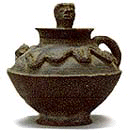
|
|
Death is the last phase of the elaborate celebration of the African life cycle . Death is recognized in Africa through a rite of passage that prepares the spirit of the deceased to journey on to the next realm. Burial Practices
In many African societies, after the body is buried, the family will have a second, more elaborate funeral. This second funeral takes place some forty days after the first burial. This allows the family to raise the necessary funds for the funeral preparations, and it gives friends and family time to travel to the deceased's home. Usually the oldest and most important people receive the most spectacular second burial. At this time, the family prepares the necessary foods and begins the period of formal mourning. They will often wear special clothing and cut, or change, their hairstyle. While black is the traditional color worn by mourners in the United States, red and white are more commonly seen at funerals in Africa. The Afterlife
In many African cultures, the idea of death is not about the ending of life, but about the continuation of life in a new phase. In death a connection continues between the spirit of the dead person and their community on earth. African artists create objects that are used to help visualize this connection between the deceased and their community, especially their family. |
| Let's explore some of these objects and the ways they are used! |
 Nurturing the Deceased |
 Dwelling Place for the Spirit |
 |
| Remembering the Deceased |
 |
 |
 |
 |
 |
 |
© Michael C. Carlos Museum of Emory University,
Memorial Art Gallery of the University of Rochester and Dallas Museum of Art
For more information please contact odyssey@emory.edu.
Last Update: